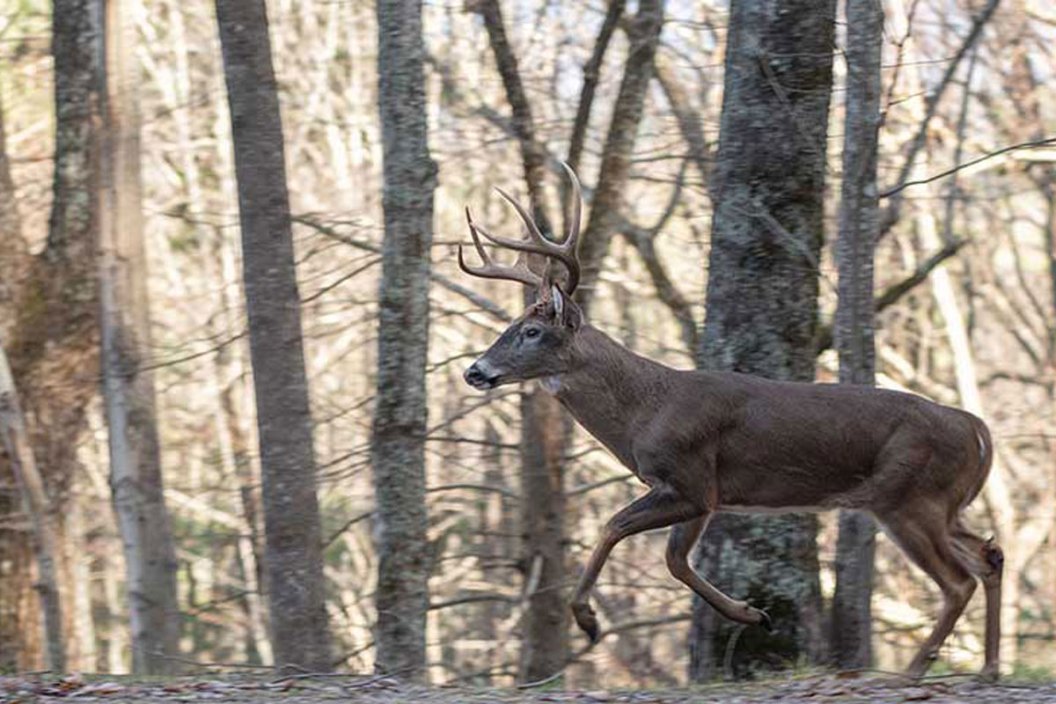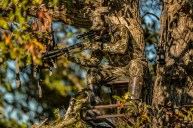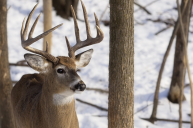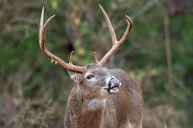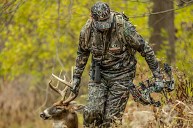Here is how to create and hunt deer funnels this season.
Deer hunting is tough. But you can up your odds of success each year by hunting funnels or pinch points that concentrate deer movement.
These travel corridors are the places all the professionals look for when trying to set up for mature bucks and you can do the same this hunting season.
We'll not only tell you how to hunt these travel routes, we'll also give you some tips to create your own and funnel deer right into your freezer.
What are deer funnels?
If you are newer to hunting you may have heard other hunters talking about funnels or pinch points, but never got a good explanation of what those are. To put it simply, a funnel is narrow point along a path of least resistance that deer use to travel from one place to another.
For instance, let's say there's a feeding area on one side of a property and a bedding area on the other. Between these two areas is a narrow area the deer trail follows. It's bordered on one side by thick cover along a wooded creek and the other side is a ridge or pond.
That's a funnel, and the narrowest point in between the two is a great spot to set up. It's the only place to go for a deer traveling between the feeding and bedding.
Another example might be where two wooded areas are narrow between agricultural fields. Big bucks don't like to expose themselves out in the open and they'll stay inside the trees when trying to get from one spot to another, especially when hunting pressure is high during deer season.
Look for hourglass shapes in the fields, woodlots or terrain. These narrow points are a prime spot to set up.
The above are examples of natural funnels, but funneling can happen because of man-made objects too. Look for places where the corners of two fencerows touch. They often create that same hourglass shape I just talked about. Also imagine a scenario where a trail is bordered on one side by a ridge and the other by a major highway or the back end of a suburban neighborhood.
Just remember that deer travel is dictated by two things, cover and terrain. Most whitetail deer don't want to climb up and down ridgetops if they don't have to. If you can find the low spot, you'll find a place where you'll see deer often.
If you're having trouble finding such a spot, you must put yourself in the mindset of the deer. If you were trying to get from your feeding area to your bedding area, which way would be easiest and offer the most cover?
Ever notice on a fence line that deer trails and other deer sign all seem to converge on the section where the fence is down? Remember that the deer aren't going to go through the thick stuff or jump high if they can avoid it.
Once you start looking at your own hunting area, you might be surprised at the things that are creating funnels where you hunt.
Once you start thinking like this, it makes it easier to scout and you'll quickly notice the spots along the route that offer fewer options for path of travel. These are hotspot stand locations.
How to hunt a funnel
https://www.youtube.com/watch?v=Bbxt-LvzVlU
Fortunately, hunting a funnel is easy enough. Try to find the point where the funnel is the narrowest or where several trails converge in a funnel and set up your treestand nearby.
You'll want to factor in the wind direction here when it comes to what side of the trail you set up on. If the wind on a setup is pushing your scent into an impassable part of the funnel like a lake or highway, it just makes it even better.
Funnel hunting is generally considered to be a solid rut hunting technique. In most cases, your stand placement isn't nearly as important as WHEN and HOW you hunt the funnel.
We don't recommend the best funnel on the property for a quick, after work sit in the early season unless you have a buck's patterns down pat and you know he'll be passing through at a certain time.
Otherwise, it's a good idea for bowhunters to save a funnel for a day you can commit to a true dawn to dusk sit. It's going to be even better if you can save that sit for prime times when the bucks are cruising for does.
Consult with a rut forecast guide and even look at moon phases to determine the best days.
For instance, if your funnel connects to a major bedding area with a major beanfield, odds are the big bucks are going to be cruising back and forth between these two areas looking for does.
The time of day they pass through may be wildly unpredictable. When the hunting pressure is on, look for more movement between noon and three p.m. Some hunters swear by midday as being the absolute best time to knock down a monster buck.
We're not going to tell anyone what to shoot. You should take whatever buck makes you happy, but keep in mind a prime funnel may result in a parade of different bucks past your stand in the course of a day. Sometimes it pays off to pass on the smaller ones in a spot like this because you never know what may come trotting down the trail just 20 or 30 minutes later.
How to create funnels in your hunting area
Now that you know how funnels work in corralling the deer straight to you, we can talk about how you can manipulate things to make your own funnels on your own property.
This is a great alternative if you just can't find that perfect spot or if you're having too many deer slip past your ambush point, especially during archery season.
One of the first things deer hunters can do is hinge-cut trees. If you're unfamiliar with the technique, it involves cutting small trees part-way through, but NOT completely off. The idea is that the top of the tree is touching the ground, but it stays alive and continues to produce branches and leaves.
Hinge cutting is often done to create made-made sanctuary bedding areas for deer, which is one way you can manipulate a funnel already in your area. Creating a bedding area should increase the amount of traffic through an already natural funnel, but hinge cutting is especially useful because you create impassable areas that the deer will naturally avoid.
Try to think of it like directing traffic. Have you found a perfect tree, but it's too far away from the trail? A little strategic hinge cutting will change the deer movements just enough that they walk right past your stand and into your shooting lanes.
Another bonus of hinge cuts is that with trees that deer like to eat, it provides browse when the tree begins sprouting more leaves.
You do have to be careful with hinge cutting because some trees, like conifers, rarely survive being cut in this manner. This defeats the purpose of hinging because then the tree is just laying there dead. It may provide a barrier for a while, but you won't get the forage benefits.
You can also create or improve funnels by installing or repairing fences. Most deer won't jump a fence unless it's an emergency. Leaving a strategic portion down or unfinished will likely result in deer adjusting their travel to fit.
Another option is to create a smaller food plot off an already established plot or crop field. Leave a narrow corridor of trees between the two where a buck wanting to check both fields for does will have to pass.
If you are clearing a wooded area for such a food source, the bonus is in the brush and trees you clear. You can place all this fallen brush strategically to keep deer out of certain areas and to strengthen the trails you want them to use. Remember, deer are lazy they're not going to do a bunch of bushwhacking through fallen limbs and trees unless their life depends on it.
Still another option is the creation of pond or lake to make a near impassable barrier on one side of an already established terrain feature. Granted, we haven't heard of anyone doing anything this extreme for deer habitat, but if you were already considering the construction of a pond or lake for fishing purposes, it's worth considering a way to place it to create a funnel and ideal stand site for the fall months.
The other bonus here is that you get a waterhole as point of interest for deer on the property.
Think "impassable barrier"
https://www.youtube.com/watch?v=DbmDwQVDm3E
That's really the most important part of creating any funnel. You are trying to either discourage deer from being in one area or you're just trying to encourage them to use another. The end goal is the same. You want those big bucks to take one route, from point A to point B, which just happens to take them past the stand where you are bowhunting.
Who knows? You may even think of a totally unique solution that applies only to your specific property. Don't be afraid to get creative and think outside the box a little bit when it comes to creating funnels. If you manage to create a must-travel path with a pinch point the deer simply can't avoid, there's a good chance your freezer will be stuffed full of venison this season!
For more outdoor content from Travis Smola, be sure to follow him on Twitter and check out his Geocaching and General Outdoor YouTube Channels.
NEXT: PUBLIC LAND HUNTING TIPS FROM OUTSIDE THE BOX
WATCH
